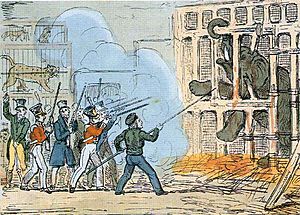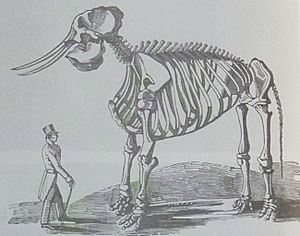Chunee facts for kids
Chunee (also spelled Chuny) was a large Indian elephant. He was brought to London in 1811 during the Regency era.
Chunee was one of three elephants brought to England. They traveled on ships belonging to the East India Company. Chunee arrived in July 1811 from Bengal. He sailed on a ship called the Astell.
Chunee was first shown at the Covent Garden Theatre. Later, a circus owner named Stephani Polito bought him. Chunee joined Polito's animal collection, called a menagerie, at Exeter Exchange in London. In 1817, Edward Cross bought the menagerie. Chunee's story became very famous after his death in 1826.
Chunee's Life as a Performer
Chunee was a very big elephant. He weighed almost 7 tons and stood 11 feet tall. He was worth about £1,000, which was a lot of money back then. Chunee was a gentle elephant and performed in plays. He appeared on stage with a famous actor named Edmund Kean.
Chunee performed in plays like Blue Beard at the Theatre Royal, Covent Garden. He also starred in a pantomime called Harlequin and Padmanaba, or the Golden Fish. This show was at the Theatre Royal, Drury Lane.
Chunee was trained to do tricks for visitors. He could take a sixpence coin from people with his trunk. Then he would give it back. The famous writer Lord Byron visited Chunee in 1813. He wrote in his journal that Chunee was very well-behaved. Byron even joked that he wished Chunee could be his butler!
Chunee's Final Days
Towards the end of his life, Chunee became very aggressive. This was thought to be because of a yearly period of excitement, possibly his musth. He also had a bad toothache from a rotten tusk.
On February 26, 1826, Chunee became very dangerous. While on his usual walk, he injured one of his keepers badly. Over the next few days, he became even more difficult to manage. It was decided that he was too dangerous to keep.
On March 1, his keeper tried to give him poison, but Chunee refused to eat it. Soldiers from Somerset House were called to shoot Chunee. Chunee knelt down when his trusted keeper commanded him. He was hit by 152 musket balls but did not die right away. A keeper finally put him down. The sound of the elephant in distress was said to be very upsetting.
What Happened Next
After Chunee's death, hundreds of people paid to see his body. Doctors and medical students from the Royal College of Surgeons of England examined him. His skeleton weighed 876 pounds (397 kg). It was sold for £100 and displayed in London. You could clearly see the bullet holes. His skin weighed 1,900 pounds (860 kg) and was sold to a tanner for £50. Chunee's skeleton was on display until 1941. It was damaged during a bombing raid in World War II.
Chunee's death was widely reported in newspapers. People printed drawings of the event. Some even published recipes for elephant stew and sad poems about "poor Chuny." Letters were sent to The Times newspaper. They protested how cruel it was and how bad the animals' living conditions were.
Because of this controversy, the Zoological Society of London was started in April 1826. Chunee's story also inspired a successful play. It was called Chuneelah; or, The Death of the Elephant at Exeter 'Change.
After Chunee's death, the menagerie at Exeter Exchange became less popular. The animals were moved to another zoo in 1828. The Exeter Exchange building was torn down in 1829.



